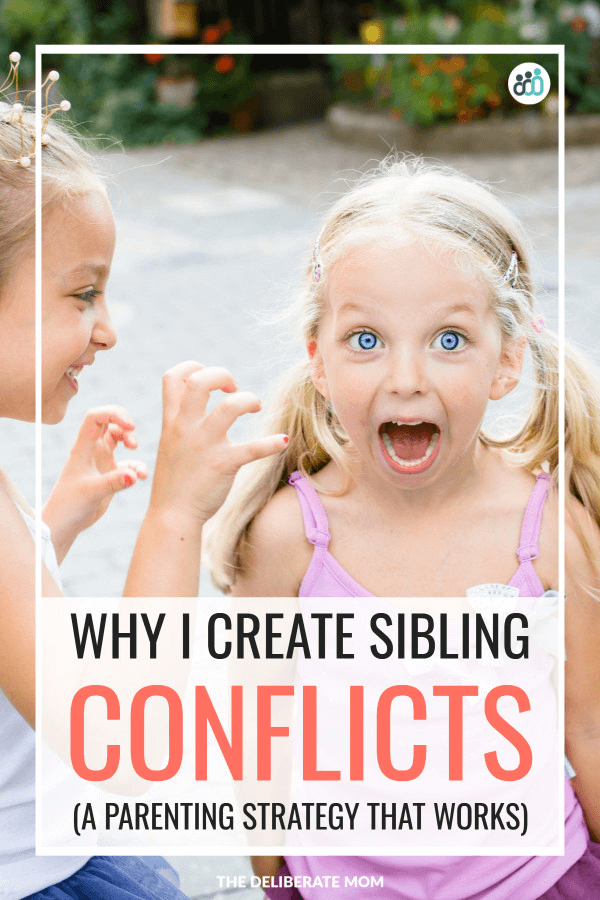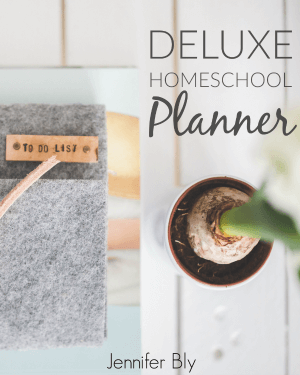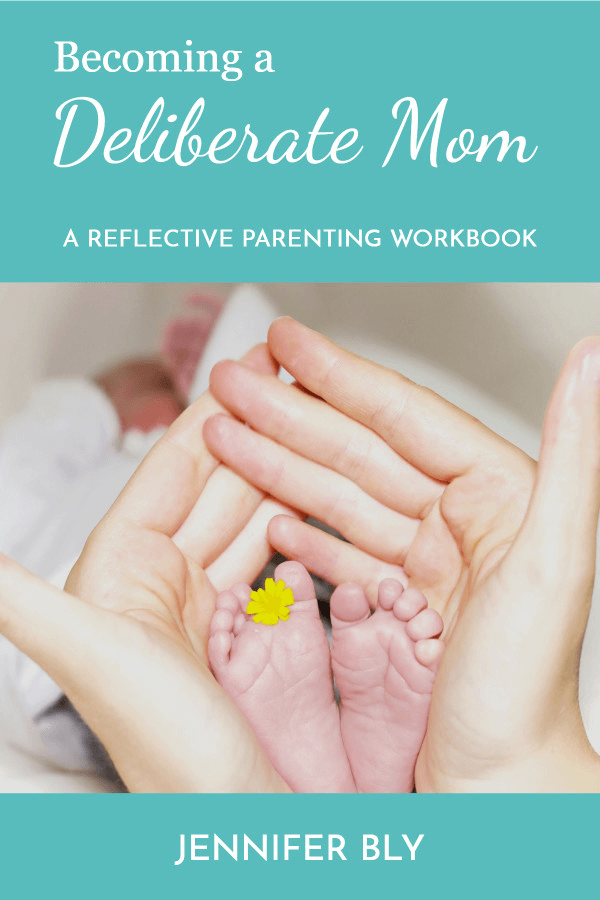Do you want a great tip for how to handle your kid’s fights; this parenting strategy involves creating conflict between my kids! It’s an unconventional parenting method, but it works!
I stood in the playground with my coworker. We casually walked around as we supervised the five toddlers with us. It was a quiet day and we were enjoying the break from our usual 10-12 children.
Then, out of the corner of my eye, I saw my coworker retrieving a doll stroller out of the shed. One doll stroller! She placed it on the tarmac, latched the door, and then stood there eyeing the children nearby.
At first I was alarmed. What was she thinking? Why would she bring out just one stroller when we have two? These kids are going to be at each other in no time!
I approached my colleague and asked why she brought out only one stroller. I made sure to also share my concerns about the children fighting.
Her response was short and curt, “We have five children between the two of us. Of all the days for me to bring out one stroller, today is the day.”
An argument almost immediately broke out between two children and she expectantly swooped in to mediate.
I ruminated on her words. The epiphany was great.
She wanted to teach these children how to have healthy conflict.
She intended on teaching the skill of conflict resolution on a day when she had ample time to facilitate the dispute.
This lesson that I learned in child care many years ago has recently come into action in my home… I cause conflict between my kids.
This mom causes conflict between her kids. Here's why. #parenting #parentingtips Click To TweetI Cause Conflict Between My Kids
My children fight. This is natural. Personalities clash and conflicts arise. This is the nature of having siblings. However, recently I’ve felt overwhelmed by the process of navigating these conflicts. The fights occurred while I was making supper and my hands were covered with raw chicken or the arguments would take place in the grocery store. These are not ideal settings to work through issues. Then, I recalled the playground scenario with my coworker and decided to implement similar opportunities to teach conflict resolution to my children.
Before I share this with you, I want to emphasize that just because I have an early childhood education degree does not mean I’m an expert when it comes to parenting. I apply some principles at home, then through trial and error, I discover if they work. This process of facilitating conflict currently works for us. This does not mean that it would work for you.
Planning for conflict between my kids
Here are the steps that I use to teach conflict resolution to my children:
1 – I decide what the conflict will be about. For example, I present bubble solution with just one bubble blower.
2 – I brainstorm all the ways my children might respond to the conflict, then I think about the ways I would like to respond to them. (i.e. “H” tries to grab the bubble blower from “G’s” hand; I wait to see if “G” says anything, if not, I intervene by saying, “It looks like G is using the bubble wand right now.”).
I find that by writing these scenarios down and by thinking about my responses, I’m more comfortable mediating issues when we’re actually in the midst of the conflict.
3 – I schedule the time that I want this conflict to occur. Things I keep in mind when scheduling the conflict:
- When is an “easy” time in our household?
- When do I feel most well rested, positive, and patient.
I find 9 am (shortly after breakfast) is an ideal time to plan a conflict between my children. Everyone is usually content, well fed, and well rested.
4 – I initiate the conflict and work through it with my children. I find it’s important to not give up. Persistence is critical.
5 – I evaluate the process shortly after I navigate the conflict. I reflect on the following:
- How did the children respond?
- What strategies worked best?
- What worked in the end?
- What would I do differently next time?
Perhaps you’re thinking you would like to try this with your own children. here are some other suggestions.
Other tips and suggestions
- Once you’ve had a successful mediation of a conflict, make sure to use that example when navigating other conflicts. (i.e. “Remember that time you were fighting over one bubble blower? Do you remember what you did to solve that problem?”)
- If they have troubles recalling how they solved a previous problem, you can offer some gentle reminders (i.e. “I remember you blew the bubbles and she popped them; then she had a turn blowing the bubbles while you popped them).
- I wouldn’t recommend doing this more than once every few weeks. It takes time, energy, and commitment to the process.
- Be gentle, especially if things don’t go well. This is why the evaluation of the process is so important. Ask yourself what will you do differently next time to ensure better chances for success?
- If you don’t have two children, perhaps you could enlist the help of a friend. Just make sure that only ONE of the adults is conducting the mediation of the conflict. More than one could be overwhelming and confusing for the children.
As I said previously, this is something that is working for us but it might not work for everyone. Each family has their own personalities and approaches.











Wonderful tips and having two little girls 16 months apart I have dealt with my fair share of sisterly conflict and need this more the you know now. So, again huge thank you for sharing this here today with us. :)
I’m so glad that you found this helpful. It’s often when they’re close in age, that they are the best of friends and the worst of enemies. The idea of this approach is to give everyone (including yourself) success with navigating conflicts. The more successes, the more they learn how to handle things on their own.
Interesting Jennifer! Even though my boys has a big gap of age one is 13 the other one is 4 they still fight… I will take in consideration this guide you provided it here to create conflict between them and the problem solving.
Sibling disputes are inevitable. The most important thing is to take the time to help them through those conflicts. If you feel you need the proper mindset and a strategy to successfully do so, then “planned” conflicts might be a strategy you could try.
Such an interesting post! You know as I’m sitting here writing this comment, I can hear my 19 month old and the 4 year old having it out in the living room. Because I built them a tent and of course the 19 month old is a little rough and kind of destroying it. Conflict conflict conflict. Luckily (lol) I just read this and now when I’m done I can go in there with the attitude of helping the 4 year old work through his frustrations that his little sister is not acting quite the way he wants her to. Instead of telling him to “deal with it, buddy”. I think for our family, the matter of conflict is constantly arising, without the need for me to add anymore on purpose. For example, during a family game night last night me and JJ won, so Cam threw a fit. We had to explain to him that not everyone wins all the time. And then don’t get me started on birthdays and new toys. And why not everyone has to share ALL the time when they’ve gotten a new toy for their birthday. There is so much conflict when you’ve got more than one child, especially when they’re close in age. But like you said, the key to it is helping them work through the conflict with your guidance, so that one day (please please please) they can work through it without your guidance. So, now that I’m done with this “novel” comment, I’m off to the trenches. Thanks for sharing!!
My kids have lots of naturally occurring conflict as well. However, I create the “scripted” conflicts to set everyone up for success. Sometimes it’s hard to have success when you’re exhausted, impatient, and then suddenly they’re at each other. Creating successful conflicts, for me, creates opportunities for them to learn and to draw on previous experiences.
The idea IS that one day, they will be able to figure things out on their own. It is well worth the “work”.
Hi Jennifer! Well, I have to say that this is a new concept for me. I can see that it makes sense, because it’s a controlled environment…I just never would have thought of it myself.
I wonder how the day went with the one stroller? Was it successful? I find this fascinating. My children fought a LOT when they were kids and I would encourage them to ‘work it out.’ I think this idea of yours would have been very helpful to give them the tools to ‘work it out.’ Very interesting!
Blessings,
Ceil
The day with the stroller had some conflicts but it really did have an impact. I remember going out to the playground again later in the day and my co-worker pointing out two children pushing the stroller together.
She used this strategy periodically and I really did see it have a positive impact… hence why I thought to try it out with my own kids. They still have disputes but we seem to get to resolution a little bit easier. I honestly think it’s because they have an opportunity to have positive “practice sessions” with it.
A concept that I never thought about. Thanks for sharing this post with others.
Thanks Susen. I think it might be a unique approach to many… and as I said, I wouldn’t expect everyone to do/try the same thing. It works for us, so I thought I would share.
Wow, this is so interesting. My initial reaction is to hate the idea of causing conflict but, when I really think about it, it makes so much sense. This is something I’m really going to have to puzzle over for myself! :-)
As I mentioned in the post, it might not be something parents would be comfortable doing.
For myself, I know I handle situations better when I have some time to think about (and plan) for them. I want my children to have successes in resolving conflict… I felt the best way to do that was to “script” opportunities for them to achieve success. Plus success is much more likely to occur when Mommy is well-rested and prepared.
The goal, ultimately, is that one day they can arrive at conflict resolution on their own without much facilitation at all.
Our days are usually flexible enough, I can stop and help as conflicts naturally arise. I am still working through how to best handle the situation. My oldest is a bit stubborn so basic explanations don’t usually work the best with her. Nothing like having homework as a parent! Great post and thanks for sharing :)
Loved hearing what’s happening in your neck of the woods Katie.
Resolving conflicts can be time consuming. I have flexibility too but I usually feel satisfied 1 out of 5 times when we walk away from the spontaneous problem solving “events” as opposed to when I’ve planned to facilitate them. The more successes, the more likely my children will be able to navigate conflict a little bit easier.
It’s practice for everyone… and yes, I often have parenting “homework” too.
Glad you enjoyed this.
I guess I had never really realized it, but I do this all of the time. Sometimes they have to learn how to figure things out and resolve conflict. I don’t solve all of my children’s problems for some of the small stuff. They need to learn independence and caring for themselves. Although I love them with all of my heart, swooping in all of the time to make things better does them very little good in the real world.
I agree that always swooping in will never do them any good. When spontaneous conflicts arise, I usually hang back for a bit to see what the kids come up with on their own. Sometimes they surprise me and they figure it all out. Other times, I’m prying one child’s fingers off of another child’s face. *sigh*
Practice, practice, practice. That’s one of the reasons why I like to facilitate conflict. Positive experiences often lead to confidence and competence.
Thanks for sharing your perspective on this.
FASCINATING! So smart! I love this controlled conflict set-up. I cannot wait to try this! I must pin this and never forget!
So glad you enjoyed this Rebecca. Sometimes I have these epiphanies and think, why not try this… it worked at daycare, it just might work with my kids!
Thanks for pinning and tweeting!
I never thought about this but it makes total sense. It’s something I’ll be practicing with my daughter. Thank so much for sharing.
I’m so glad you enjoyed this Carolina! Thanks.
I had never thought of it this way, but you are one wise women and momma!! Taking notes for when it’s our turn ;)
Thanks Caroline! Yes, take those notes my friend! By the way, you’re my 6:00 Facebook Shout-Out tonight :)
Ah, your parenting advice always resonates with me! This is something that would be great to implement right now because my two boys are learning about sharing with each other (as best they can, I know at 1.5 and 3.5 they are super young to understand the concept fully). I never thought to do something like this, and I love the way you are so involved with the process. Thank you for the tips!
You’re so very welcome Jessica. I find that the “practice” is not only good for them, but good for me too!
I’m so glad you enjoyed this.
It’s nice to read this now. My kids don’t have a lot of conflict.. yet.. but boy do I know it’s coming. I can’t remember NOT fighting with my sister until college. And now we never do. You sure learn a lot about conflict with four siblings!
I never really thought about this, but it makes so much sense.
I’m so glad you enjoyed this Tamara. It’s so important to teach our children how to navigate conflict successfully on their own.
Hi Jennifer, I love the fact that you don’t claim to be a child expert even though you have a degree in early childhood education; it’s refreshing!
And it’s such a good idea to instigate conflict in a controlled environment, like a social experiment. Children must learn to share and what better way than when Mum/teacher/babysitter has time to intervene if need be.
A great post!
I’m delighted you enjoy this Debbie.
While I was in early childhood education, I used to stand by the philosophy that parents/families were the “experts” when it comes to their own children. Although, I must say, as a parent, I sometime don’t feel like an expert when it comes to my own children.
Thanks for your lovely and encouraging words.
Jennifer,
Wow, you really are a deliberate mom! I am amazed by your smartness! Yep, that’s right, I said your smartness. =)
If I were to explain what kind of mom I am it would probably be… the haphazard mom. But I think you’re absolutely right. We have to give kids the opportunity to solve their own problems, and those kinds of conversations are exactly what will make them well-adjusted adults. Well done, you!
Smartness?! I’ll take it!
I’m delighted you enjoyed this Brittany. I feel that as a parent, I need to give my children the tools to function when they are out in society. Having healthy conflict is an essential tool.
Thanks for your kind and encouraging words.
This is one of the reasons I like it when our neighbors come over to play video games, I like watching them decide which game they will play and who will go first and so on. I never thought of setting them up for it though, I think that is a great idea.
Thanks Lauren. Yes, this strategy has worked very well for us.
Wow! I would never have thought about creating conflict for my children so that I can oversee and help them work through it. What a brilliant idea. This is something I want to try with my kids because as you said it seems like they always want to fight and argue when it is a moment that I’m not prepared or can’t use as a teaching tool. If I can create situations and help them work through them then we can be better prepared for these other moments. Thanks for sharing your wisdom. Hope this can work with my kids, too!
I love this approach because I’m committed to the process. We don’t have to go anywhere or do anything… I’ve set the stage for the conflict to occur at a convenient time. My children need to practice everything… including practicing how to have healthy conflict and how to problem solve. I don’t want to solve their problems for them, so they need to practice how to solve things for themselves.
Glad you enjoyed this and I hope that this process works for you as well.
My boys are 9 and 13 and it seems like I don’t have to cause any because they do such a good job by themselves when we’re at home. I very rarely intervene because in about an hour they’re the best of friends once again. Those are great tips though, very good tips!
Thanks for sharing what things are like in your home. I’m glad you enjoyed these tips.
Interesting concept. I tend to let them resolve their conflict but I do sometimes “intervene” to help them through it, I just never thought of actually setting up a conflict!
Thanks Ana Lynn. It’s practicing conflict in the “safest” manner possible. It takes time and commitment but I think the benefits are worth it.
I would have never thought to do this. I spend all my time trying to diffuse conflict with A, and she’s an only child, ha! This post screams deliberate mom Jennifer. I love it. :)
Have a great Wednesday!
xoxo
My site is being repaired right now so I’m replying through email. I’m so glad you enjoyed this post. Yes, this is definitely screaming “The Deliberate Mom” isn’t it?! There’s a reason why I came up with that name!
If you could let me know if you received this comment, I would greatly appreciate it!
xoxo
That’s really impressive. My daughters are two years apart, so MANY conflicts occur. And while I don’t swoop in and resolve everything, I haven’t thought of the idea to actually plan a conflict. Something I’m going to be mindful about is what you mentioned about setting the right time of day. That would be so important with us!
I’m so glad you enjoyed this Celeste. My daughters are 3 1/2 years apart and they were having quite a few conflicts. I’m starting to see our “planned conflicts” paying off though! Just today i heard my oldest giving different choices for how they could share a toy together. AWESOME!
I hope this strategy works for you.
I have never heard this idea before but I love it! Planning conflicts so that you can teach proper skills makes total sense – as opposed to trying to do all the teaching when you’re hands are covered in raw chicken (happens here too). Can’t wait to try this!
Thanks Tricia. I think children need to practice all sorts of skills. Why not practice having healthy conflict? It takes time and commitment but I honestly think the results are well worth it.
I don’t schedule conflict (although I love the idea), however, I cause it all the time. Especially because I have two kids the same age and I never buy two of the same thing.
The Kids either decide to share or one decides that it’s not important enough to get into a conflict. Sometimes,I’m pretty sure that if there isn’t any conflict then they aren’t even interested in the item. Great post, thanks for sharing.
Besos, Sarah
Blogger at Journeys of The Zoo
I agree with getting single toys as opposed to multiples… a great way to have “natural” occurring conflict. I’m delighted you enjoyed this Sarah!
Great post with some great tips! It’s very hard for me not to get involved with my children’s conflicts. Since my older child has special needs, i.e., high-functioning autism, it sometimes throws off the balance of the arguments, so that I have to step in. However, I do try to make sure I step back every once in a while and see if they can figure out a happy medium.
One time, at a playgroup quite a few years ago, my son and a friend were arguing about something, and I stepped in. The other mom suggested I just let them work it out. I’d never thought to do that, and I actually appreciated her suggesting it because it made me think about how my stepping in is not always the best solution.
Thanks! I agree that sometimes we just need to step back and let our kids figure things out. As I shared here too, I also think that kids need to be taught the tools necessary to handle conflict in a healthy manner.
Thanks so much for stopping by – I love hearing other parents’ perspectives.
Found you through SITS. Love this especially since my youngest is 4, my other two are 9 and 12. Although conflict already seems to find them automatically it could be good to set up a “controlled” scenario with a script of some sort rather than yelling at everyone at once….
The controlled scenarios really help with coaching them through the process of conflict resolution.
Thanks for stopping by – I love the SITS Sharefest!
I am going to have to remember this one when I have more than one kid.
It’s definitely a useful parenting tool Kristie!
What a great post. It is so important to teach children from a young age how to deal with conflict. Thanks for the read xx
#Shinebloghop
Agreed! I think teaching children how to candle conflict is just as essential as teaching them how to brush their teeth! It’s a skill that will have an impact on their entire life.
Thanks for visiting Lydia!
LOVE THIS! Thank you for sharing such a thoughtful and intentional way to create such an important life skill. I’ve always heard about taking advantage of teachable moments, but never thought to informally make them occur. Saving this for the {near} future!
So glad you enjoyed this Farrah. Yes, teachable moments are critical but I do believe that sometimes it’s important to create those moments too.